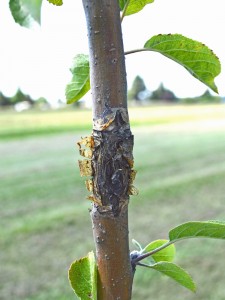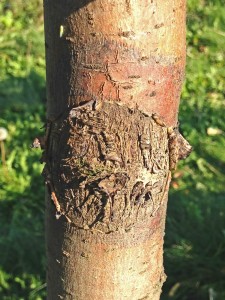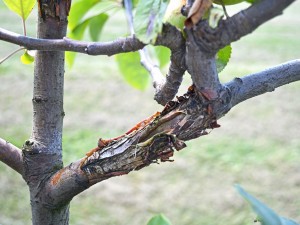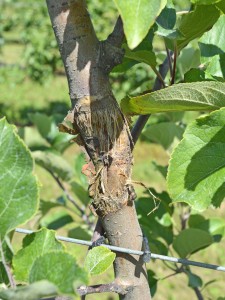Written by: Whitney Garton, MS candidate, Department of Horticulture, Mount Vernon NWREC, Washington State University; Frank Dugan, Research Plant Pathologist, USDA-ARS Western Regional Plant Introduction Station, Pullman, WA; Mark Mazzola, Research Plant Pathologist, USDA-ARS, Wenatchee, WA; and Carol Miles, Professor, Department of Horticulture, Mount Vernon NWREC, Washington State University. Published: June 2016
Introduction
Apple anthracnose is a fungal disease that significantly impacts apple production in the maritime Pacific Northwest and in regions with similar climates. The fungus produces cankers on trees and a post-harvest fruit rot known as “Bull’s-eye rot”. The cankers serve as the source of inoculum for inciting the fruit rot phase of the disease and can limit long-term orchard productivity. Species within the fungal genus Neofabraea are the causal agents responsible for production of apple tree cankers and Bull’s-eye fruit rot. The geographical distribution of Neofabraea species varies significantly with the environment, with tree cankers (apple anthracnose canker) west of the Cascade Mountains attributed to Neofabraea malicorticis, whereas tree cankers (perennial canker) east of the Cascade Mountains are attributed to Neofabraea perennans. Other potential disease-causing species are Neofabraea alba and Cryptosporiopsis kienholzii.
Apple Anthracnose
In areas west of the Cascade Mountains, apple anthracnose is caused by the fungus Neofabraea malicorticis (synonyms Pezicula malicorticis, Cryptosporiopsis curvispora). The maritime climate with mild year-round temperatures, abundant winter rains, and cool-humid summers is critical in the development and virulence of this disease. The canker phase is considered the most serious phase of the disease because it can cause severe damage to trees, kill newly planted trees by girdling the stems and branches, and reduce overall tree health and yield in established trees (Fig. 1). Growers in the maritime Pacific Northwest have reported removing 2-5% of trees each year and in some cases entire orchard blocks to prevent the spread of cankers. The cankers serve as the source of inoculum that incites “Bull’s-eye rot”, which develops on fruit in storage. The post-harvest rot produces lesions on the fruit skin that appear as circular, flat or slightly sunken spots that are brown with a pale center that forms a bull’s eye.
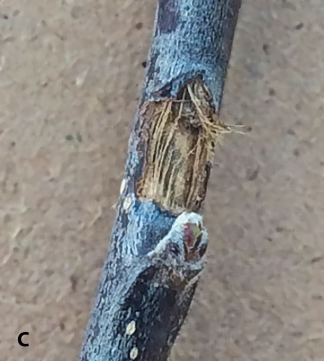
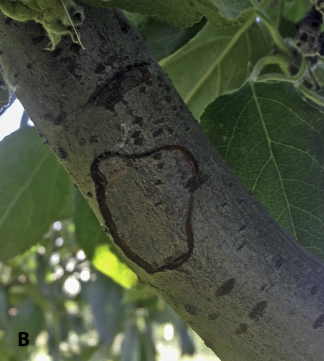
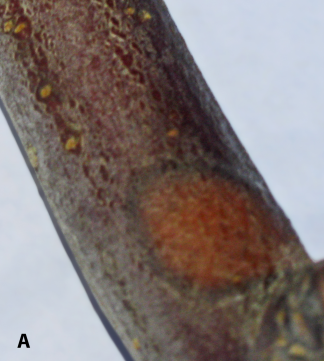
Fig. 1 Apple anthracnose canker progression. (A) First symptom of infection, (B) Infection causes separation of necrotic bark tissue (C) Matured canker “fiddle-string” appearance. Photos by Whitney Garton.
Apple Anthracnose Canker
Infection generally occurs during fall rains and first appears as a small, circular red spot on the bark; new cankers are most visible when the bark is moist. The discoloration extends into the tissue as far as the sapwood which contains the functioning vascular tissue. As the lesions enlarge, they become elongated, sunken and turn an orange to brown color. A margin develops between healthy and necrotic tissue, causing the bark to crack around the infected area. During the winter months, the pathogen goes dormant and canker progression ceases.
In spring, the fungus resumes growth under favorable conditions and canker expansion progresses most rapidly up and down the branch when sap flow is initiated. By mid-spring the canker becomes fully mature (Fig. 2). By midsummer, about a year after infection, the pathogen will begin producing conidia on the matured cankers. Conidia are asexual spores that are contained in fruiting bodies known as acervuli. The fruiting bodies appear as cream-colored and protrude outward from the bark. Fungal spores appear to infect healthy bark, and mycelial growth occurs in the cambium beneath the bark for a period of time before killing the bark itself to form a visible canker. The pathogen can live for several years in necrotic bark tissue, producing spores each year. The conidia produced on the dead canker bark are exuded in a gelatinous matrix and disseminated by rain splash to other parts of the tree, surrounding trees and fruit, causing new infections.
Management in orchard
Disease management relies heavily on pruning out the cankers to remove the inoculum source. Stems or trees that are heavily infected with cankers should be removed from the orchard and burned.
Chemical controls
Because cankers are often overlooked, fungicide treatments are needed in conjunction with pruning. Currently, there are no systemic pesticides that will control the disease. Refer to the Pacific Northwest Plant Disease Management Handbook for more information on pesticide use.
Fig. 2. Mature apple anthracnose cankers. Photos by Whitney Garton. Click on image to enlarge.
Bull’s-eye Rot
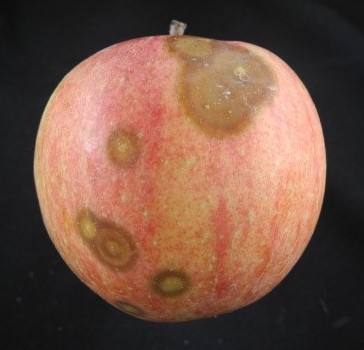
Bull’s-eye rot, caused by Neofabraea species, occurs both on apple and pear in the maritime Pacific Northwest. The fruit becomes susceptible to infection by the fungus in areas or years with frequent rains near or during harvest. Conidia from the cankers are the source of inoculum that causes infection. The conidia germinate on the fruit surface, and enter the apple through the lenticels (stomata) or breaks in the skin, and form appressoria, which are specialized cells that facilitates attachment and penetration of the host by the fungus. Fruit can become infected any time after bloom and susceptibility increases as the growing season progresses. Infections remain latent in the fruit and become active after 4-7 months in storage. Symptoms first appear as brown, depressed, circular spots that are flat to slightly sunken with a light brown center; spots may occur singly or be numerous (Fig. 3). As the spots extend, fungus fruiting bodies (acervuli) develop in the center, often in concentric rings giving the appearance of a bull’s eye. The fruiting bodies of the fungus are not always present. When the fruiting bodies are present, they protrude through the fruit skin as short, wet, cream-colored masses in the decayed area. The decayed tissue is somewhat mealy and firm, and does not separate easily from healthy tissue.
Several Neofabraea species can infect fruit and each species causes specific symptoms. Infections incited by Neofabraea alba develop as a soft rot with white mycelium that covers the rot, releasing white spore masses. An infection incited by Neofabraea perennans appears as circular, sunken, brown lesions and the center of the lesion is much paler than that of lesions caused by N. alba. Infections incited by Neofabraea malicorticis cause lesions that are circular, brown, and sunken with gray to cream-colored acervuli that are often apparent and concentrically arranged in the center of the lesions. The importance of the different Neofabraea species that incite bull’s-eye rot on apples is dependent on the growing region. The presence of cankers and climate of the region determine the amount of inoculum of a particular species in an orchard.
Management in orchard
Refer to canker management above.
Management in storage
Keep fruit dry after harvest and remove fruit from the orchard as soon as possible. Induce rapid cooling of fruit and store in a low oxygen atmosphere. The extent of infection can be estimated by exposing a sample of fruit to high humidity and temperatures between 64 – 70 °F for one month. Fruit with significant incidence of Bull’s-eye rot should be marketed early.
Chemical controls
Fungicides should be applied before fall rains at petal fall and pre-harvest. Refer to the Pacific Northwest Plant Disease Management Handbook for more information on pesticide use.
Chemicals available for use in Apple Orchards
Excerpt from the WSU Crop Protection Guide. For timings at which each pesticide can be used refer to the Crop Protection Guide.
d = dormant; dd= delayed dormant; pp= prepink/pink; b = bloom; pb = post bloom; sf = shuck fall; es = early summer (14-32 after full bloom); s = summer; ls = late summer; ph = preharvest; h = harvest; ah = after harvest
Perennial Canker
Perennial canker is caused by the fungus [Neofabraea perennans (synonyms Pezicula perennans, Cryptosporiopsis perennans)] which is closely related to the fungus causing apple anthracnose canker. It is prevalent in regions where summers are hot and dry, and winters are severe. The causal organism enters through wounds or injuries from the woolly apple aphid (Eriosoma lanigerum). As the canker develops, the host produces a raised layer of callus tissue, separating the diseased tissue from healthy tissue. As the canker enlarges, it cuts off the sap-conduction tissue, resulting in a reduction of growth and yield and sometimes death of the tree. Over time the cankers consist of a series of concentric callus rings of woody tissue encircling the wound. First-year cankers appear elliptical, sunken, and orange, purple, or brown color. The fungus survives the winter as mycelium and conidia in cankers and in infected fruit left in the orchard. Conidia are exuded from acervuli in a gelatinous matrix and dispersed by rain splash to wound sites where new infections occur. The acervuli are black and protrude through the epidermis of host tissue. Sporulation typically occurs during autumn and winter depending on the environment. The cankers enlarge in late winter and early spring. The annual reactivation of cankers depends mainly upon the presence of woolly apple aphid, which is attracted to the succulent callus tissue around the canker margins, creating wound sites where new infections can occur.
More Information
Sources
Pscheidt, J.W. and Ocamb, C.M. 2016. Apple (Malus spp.) Perennial canker (Bull’s-eye rot). Pacific Northwest Plant Disease Management Handbook. Oregon State University.
Pscheidt, J.W. and Ocamb, C.M. 2016. Apple (Malus spp.) Anthracnose (Bull’s-eye rot). Pacific Northwest Plant Disease Management Handbook. Oregon State University.
Sutton, Aldwinckle, Agnello, and Walgenbach. 2014. Anthracnose canker and perennial canker. Compendium of Apple and Pear Diseases and Pests, 2nd edition 51-53.
Use pesticides with care. Apply them only to plants, animals, or sites listed on the labels. When mixing and applying pesticides, follow all label precautions to protect yourself and others around you. It is a violation of the law to disregard label directions. If pesticides are spilled on skin or clothing, remove clothing and wash skin thoroughly. Store pesticides in their original containers and keep them out of the reach of children, pets, and livestock.
YOU ARE REQUIRED BY LAW TO FOLLOW THE LABEL. It is a legal document. Always read the label before using any pesticide. You, the grower, are responsible for safe pesticide use. Trade (brand) names are provided for your reference only. No discrimination is intended, and other pesticides with the same active ingredient may be suitable. No endorsement is implied.
Treefruit.wsu.edu articles may only be republished with prior author permission © Washington State University. Republished articles with permission must include: “Originally published by Washington State Tree Fruit Extension Fruit Matters at treefruit.wsu.edu” along with author(s) name, and a link to the original article.
